Bowling Green, Kentucky, is steeped in history and Southern tradition. Mostly, the city of about 68,000 people is recognized as the home of Western Kentucky University, the National Corvette Museum, and Lost River Cave, which hosts daily boat tours and gem-mining excursions.
But Bowling Green also is home to Enlighten, one of the most sophisticated technology companies in the cannabis industry and a key service provider for thousands of dispensaries and ancillary businesses across the United States.
Founder and Chief Executive Officer Jeremy Jacobs is a Kentucky native, longtime cannabis activist, and technology wonk. He and his team specialize in building products and services that deftly navigate a complex web of state-specific regulations and offer clients an in-depth, real-time view of a fickle and often befuddled customer base that grows by the minute.
When Jacobs scouted a location for his company headquarters, he landed in one of the most tech-savvy locales in the state: Western Kentucky University’s Center for Research and Development, which resides in a renovated shopping mall near campus. There, Enlighten has 24/7 access to a $10-million supercomputing facility, a business accelerator, and a conference center. Like many of the unorthodox, savvy moves he’s made over the course of his career, the location made sense then and is paying off now. Enlighten’s office incorporates a leftover bank vault, and the Mexican restaurant in the building cooks up “some of the biggest shrimp you’ve ever seen,” he said.
When Jacobs discusses his career and accomplishments, his self-deprecating, wry sense of humor always provides a colorful backdrop. “Entrepreneurialism drew me away from traditional education,” he said. “Western Kentucky has always held a special place in my heart. It was the last college I dropped out of.”
Digital marketing
Ever since the recreational cannabis market took flight in Colorado in 2015, Jacobs has had a bird’s-eye view of how, where, and why people buy weed in nearly every United States market. During the early days, dispensaries treated customers to TV screens scrolling content and ads provided by one of Jacobs’s companies. Nowadays, Enlighten’s multi-platform ecosystem also offers consumers coupons and helps them locate dispensaries around the corner or across the country in addition to providing hardware and software for the company’s content network, digital menus and signage, and ordering.
“I think 8,500 is the biggest number I’ve heard for total dispensaries [operating in the U.S.],” he said. “In other industries, by comparison, there’s a quarter million schools, a quarter million restaurants, and a quarter million factories in America. But cannabis is such a small market, so you can’t afford to miss [any potential customers], and you have to make sure every shot counts. That’s the biggest challenge I see.”
This isn’t Jacobs’s first rodeo. Well before he became a cannabis-industry heavyweight, he launched, and still owns, a company that provides digital menus and signage for restaurants and other businesses. After recognizing the potential for software to turn TV screens into networked digital communication systems, he created a product that—long story short—turned David’s Steakhouse and Buffet in Corbin, Kentucky, into the proud owner of the first interactive digital menu in the U.S.
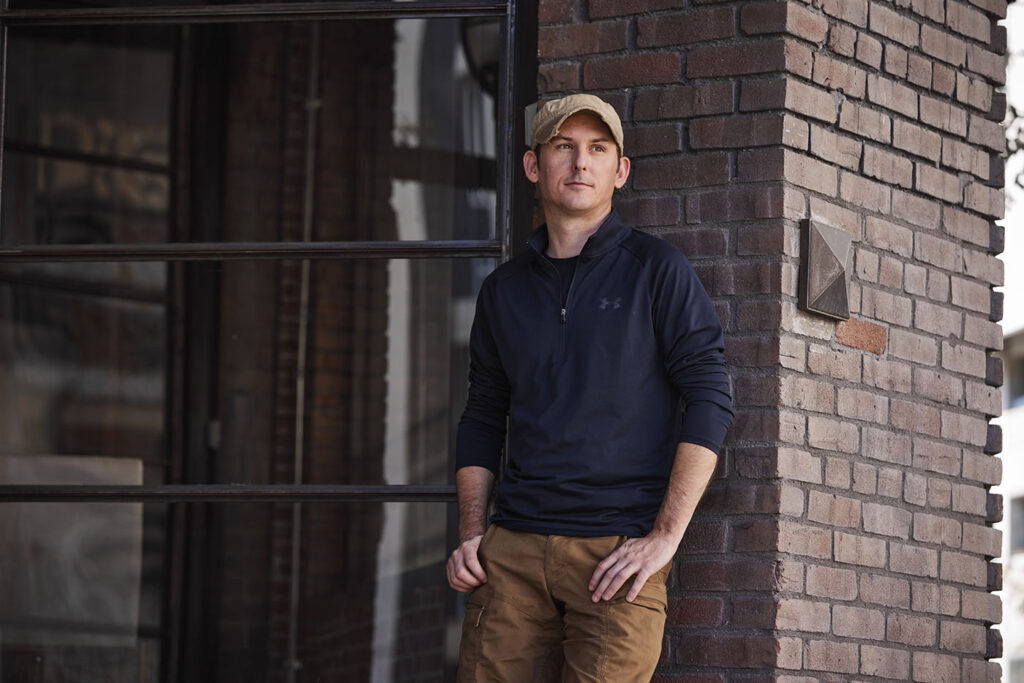
“That was my first major success, and then [food distributor] Sysco started selling [the system] and it took flight,” he said. Next, he developed a digital directory that went on to replace the ubiquitous black felt boards with white plastic letters.
Jacobs’s entrée into the cannabis industry came a short time later, when a friend asked him to create kiosks and advertising screens for the burgeoning adult-use market in Denver. “That was probably one of the most special moments of my life, because it was a marriage between two of my favorite things: cannabis and technology. I was ecstatic, and so we dove in. It was the birth of what is now called Enlighten.”
The dropout entrepreneur
Jacobs grew up in a one-horse town in Kentucky. His parents supported his early entrepreneurial efforts, which started at age 12 with a lawn-care business. By the time he graduated from high school (with a whopping total of 286 other seniors), he had a full-time job and fixed car stereos and waxed houseboats on the side.
“College wasn’t on my list of priorities as I think it would be for most people with a 4.0 [grade point average], because I just wasn’t a big fan of conventional learning,” he said. So, unsurprisingly, when he landed at Georgetown University on a full-ride scholarship, he didn’t enjoy the experience. He transferred to a community college and eventually landed at Western Kentucky University, where he remained unimpressed by the hallowed halls of higher education.
At that time—the late 1990s—Google was busy reinventing the web, giving everyone everywhere unprecedented access to previously unimaginable amounts of information. “Anything you wanted to know, you just had to Google it,” Jacobs said. “You didn’t even have to go get books anymore. That was a big change in the environment.” With that realization, he allowed himself to be lured into the workaday world by a job “selling credit card machines and things of that nature,” he said. “And I was making more money than professors at the school.”
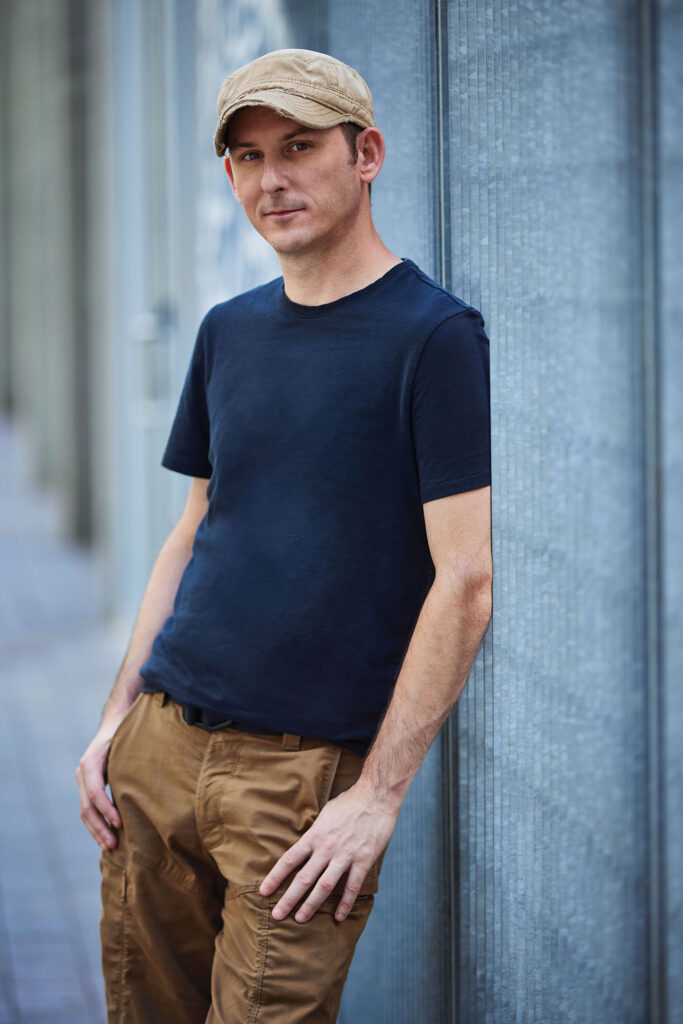
Although higher education held no allure, Jacobs suspected professional certifications might feed the entrepreneurial bug he’d caught in his youth. “I looked at the insurance industry, the real estate industry, and then I chose the investment industry and acquired early on a laundry list of securities licenses and investment licenses,” he said. “And for years, I spent time in capital markets and fundraising for technology companies, energy companies like biodiesel, helping them structure their deals better and reorganize their management and get things on point from a marketing and product-development standpoint.
“Well, that continued on until I learned so much about energy technology funding other people’s projects that I just sort of organically ended up in the natural gas business,” he continued. “I looked up one day and I owned tens of thousands of acres in eastern Kentucky with a bunch of old natural gas wells on them, and I started using a new technology we had developed to open up these seemingly dead natural gas wells and return them to life. So, basically, one man’s trash is another man’s treasure.”
What most fascinated Jacobs, though, was technology’s potential to revolutionize a hidebound industry. “What was interesting to me was all the technology implemented out in the [natural gas] fields,” he said. “I had computer systems and software to track where people were and what parts and supplies they used and who to bill that to. I knew everything that was going on. And in the natural gas field, that was just not very common. People had notepads and Sharpie markers and they were keeping really terrible notes, but we knew everything about everything and it was all digitized.”
He made substantial margins selling gas into the market for three years…until the bottom dropped out of the industry in 2008. “Essentially, everything I had worked for effectively dissolved along with the rest of the economy,” he said.
Not easily discouraged, he was looking for his next move when it practically landed in his lap. “I had been to an airport recently and saw my first digital sign,” he recalled. “The next thing I know, a friend of mine calls me and says, ‘Hey, I want you to come look at something.’”
That something was a digital sign composed of two seventy-inch Panasonic televisions married to a desktop computer and corralled inside a metal case. Set up inside a shopping mall, the system played Adobe Flash video ads on a loop. “I sat in the mall that day he showed it to me and stared at it for hours,” Jacobs said. “And what I realized was the world was about to evolve—that television screens and computers had gotten so cheap and commoditized that now the power of a TV network wasn’t going to be owned by just the TV networks anymore. Now I could build a TV network in a mall or in restaurants or wherever I wanted to, and I really started to analyze what all we could do with that. What other sort of signage could it replace? Because it’s enormously more attractive. And that was the spark of my company Eyeconic.”
And Eyeconic spawned Enlighten.
And the rest, as they say, is cannabis history.
Educating consumers
All entrepreneurs must possess one critical skill: the ability to quickly identify problems, headaches, and challenges in new markets and devise creative solutions. This is where Jacobs lives and breathes.
When he started researching the cannabis industry, he identified two major pain points and built his business plan around solving both. One of the most obvious and immediate issues was a lack of educational resources. To address the situation, he created a series of educational videos that stream on Enlighten’s television network, an on-demand platform that allows dispensaries to change the content. The videos address a multitude of consumers’ common cannabis questions—about products, how they are produced, and their effects. How will vaping make me feel? How is flower processed into edibles? What are trichomes? What is CBD? What’s the difference between hemp and marijuana?
“All these questions are in a repository, and we allow dispensaries the ability to disseminate quality education in one way or another,” Jacobs said. “Some of the products are free, and some of them have a small fee. But we’ve opened it up and gathered all of these educational videos and built the largest cannabis educational video library in the world to be able to do these things.”
Jacobs also set out to address supply inconsistency. People like to compare weed to craft beer, he said, but beer is brewed in consistent formulations in batches composed of thousands of gallons. Flower, extracts, and edibles are altogether different beasts. “You have enormously small batches that move in extremely rapid velocity, so you run out of Banana Kush, at 27-percent THC, maybe within hours,” he said. “That’s a big, big challenge cannabis has struggled with. There were just no integrations that existed between the point-of-sale (POS) companies and the consumer-facing points” to help retailers smooth out the rough patches along the supply-and-demand chain.
His solution to the problem was to create “SmartHub,” a real-time, integrated POS system that keeps dispensary menus in sync with inventory 24/7, preventing those frustrating moments when a customer orders something only to discover it’s not in stock.
Enlightening data
Jacobs said about 200 million people in the U.S. have touched cannabis on a device in some way, and through his technology products and platforms, he likely has more data and a deeper understanding of their behavior than anyone else in the industry.
Enlighten’s technology platform includes a number of different products and services, many of them aimed at informing and educating customers and employees—interactive signs, a retail analytics portal, applications to aggregate and systemize product offerings and operations, and tailored marketing solutions for brands. Using the ecosystem, his clients are able to learn an immense amount about customers’ shopping and purchasing behavior, and in some cases track their movements from store to store and state to state. The software can track the number of visitors to various locations, how long they stay, how frequently they return, the duration of their visits, and other metrics. After collecting this immense amount of data from thousands of dispensaries on a daily basis, Enlighten correlates transactions at the point of sale with other pertinent information to develop trends and profiles of consumer behavior. These lead to targeted advertising opportunities.
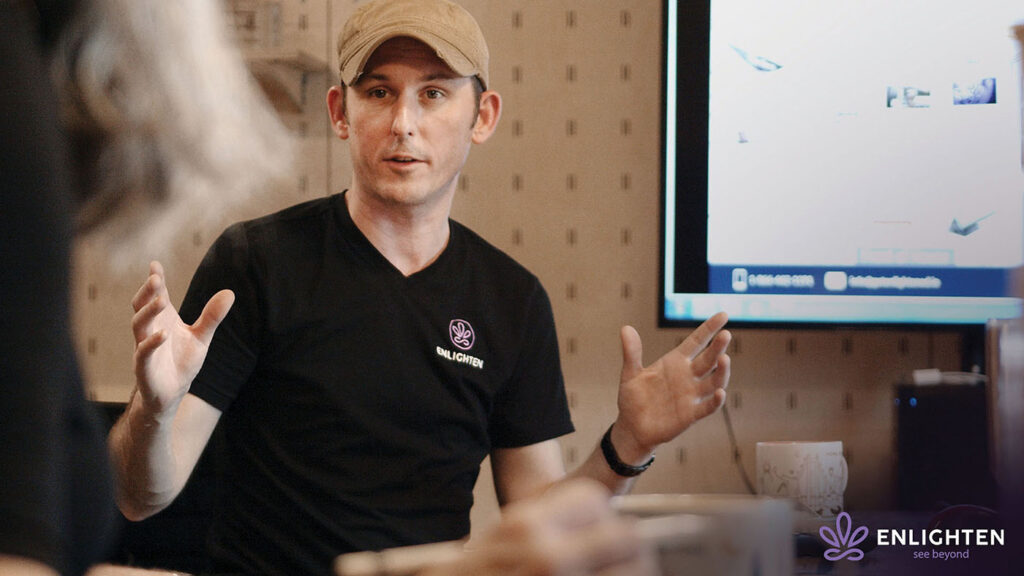
“What we’re most interested in with the data is ‘How do I generate revenue with this for my customers?’” Jacobs said. “‘How do I help retailers use this information to generate revenue for brands?’ We look at consumer data and can activate to a specific customer so they’re getting an advertisement that’s more relevant to them. So, the click-through rates are higher and the purchase rates are higher and the attribution is there so an advertiser can see the return on an ad spend.”
When the Enlighten platform targets a customer for an advertisement or coupon, the system has to be certain it’s identified individuals who are bona-fide cannabis consumers of legal age. From state to state, complex and variable regulations dictate where and how ads can be served, and it’s no small feat to determine how and where messages can be broadcast legally.
According to Jacobs, the difference between a successful mainstream cannabis placement and failure is compliance. “Compliance in cannabis advertising means eliminating risk exposure for publications and brands,” he said. “Enlighten targets known cannabis consumers, identifying those consumers and leveraging data from various sources, including partnerships and our proprietary, sophisticated technology. We make those connections simple, effective, and compliant—not just cannabis-compliant, but also marketing-compliant. And no personally identifiable information is shared.”
Using Enlighten’s AdSuite, clients have placed digital ads for major cannabis brands on sites belonging to Health, GQ, Vanity Fair, Vogue, Sports Illustrated, Cosmopolitan, USA Today, and Major League Baseball.
A weed activist in a bourbon-soaked state
Bring up almost any topic related to cannabis in conversation, and Jacobs will offer an informed, insightful opinion that might make your head spin with details (and provide a few good laughs along the way). He’s an enthusiastic entrepreneur and an equally passionate advocate. From 2017 through 2018, he served as executive director for Kentucky NORML…which he likened to being Bernie Sanders’s campaign manager in Alabama.
“Kentucky will be one of the last states ever in the history of the world to legalize cannabis,” Jacobs said. “You have to remember this is bourbon country, and we’re very protective of the industry. So, [legalization is] a standard issue of who’s paying the politicians, and you see it all the time. The good elected officials that haven’t been [in office] a million years and aren’t bought and paid off are sensible. When you show them cannabis isn’t harmful, they change their mind. But those other guys, they’re bought and paid for, brother.”
Undeterred, Jacobs continues making the case for legalization in Kentucky and other states, and one of his favorite ways to do so is in TheRealCannaBus, a forty-foot, custom-built, high-tech dispensary on wheels. The interior is outfitted with digital menus, interactive kiosks, and even fake cannabis flower in canisters along the walls. A lounge in the back contains a custom purple leather sofa and a high-efficiency air-filtration system. Jacobs uses the bus to educate policymakers, connect with cannabis brands and customers, and advocate for the industry and legalization. TheRealCannaBus visits conventions and state capitals, where it’s used to show politicians cannabis is an essential business and an important and growing part of the U.S. economy—not some frightening, mysterious well of social depravity.
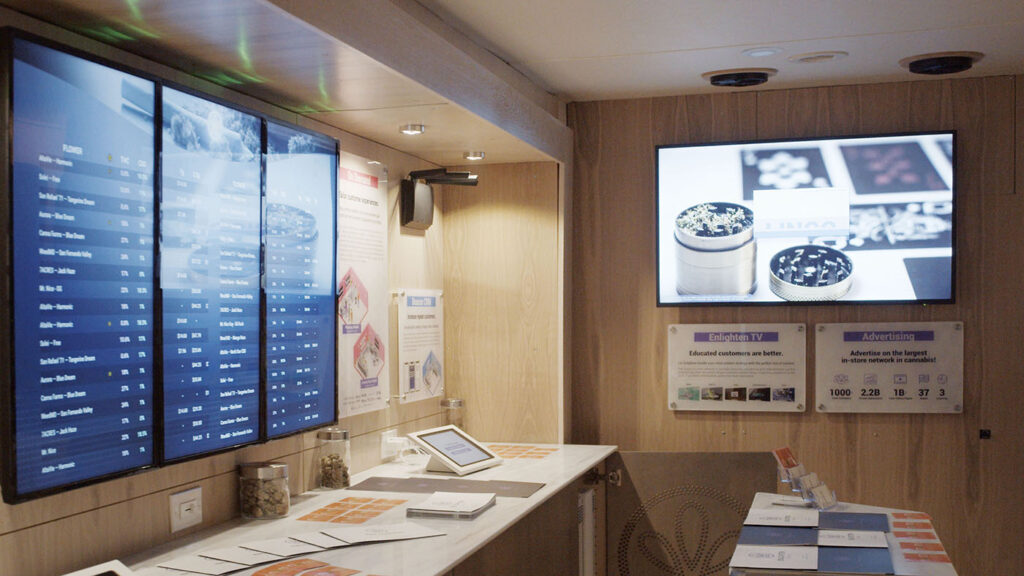
“I’ve been known on many occasions to take [the bus] to a capitol building so these elected officials who think marijuana dispensaries are dark dungeon places with Jimi Hendrix posters and black lights can walk inside this super-high-end interior that looks like an Apple Store,” he said. “It’s got hundreds and hundreds of educational video files that teach about cannabis and the history of cannabis… I think it’s probably the most impactful thing I’ve done as an advocate. It really unites everyone and invigorates them and puts the wind in their sails so they will keep up the good fight.”
A drive-through future
When he shops in dispensaries on the West Coast, Jacobs sometimes spends several thousand dollars buying one of every vape cartridge he can find. That said, he admitted, the last thing he wants to do is wait in a line or interact with a budtender. “The buying experience I enjoy is a large-format touchscreen kiosk like you see when you go to McDonald’s, because the chances of [the product I want] actually being in stock are far more likely,” he said.
“Especially if it’s an Enlighten kiosk,” he added with a wink. “Then I know it will be in stock.”
Although he understands why some consumers enjoy interacting with budtenders—in order to learn more about products, for example—he firmly believes the future of retail will employ technology platforms like Enlighten to conduct transactions. He also believes dispensaries may want to take cues from quick-service restaurants.
“Eyeconic arose in the restaurant industry, right? So this is a no-brainer for me,” he said. “You need drive-throughs, you need kiosks, you need TV menus, you need apps, you need listing services. The future of cannabis is going to look a lot like a quick-service restaurant. But the products are not commoditized, wrapped-up cheeseburgers; they are highly branded, attractive consumer packaged goods. So, there will be a number of ways technology, from a consumer perspective, is going to integrate into the dispensary.
“Just mark my words,” he added. “Right now there might be five dispensaries in the nation with a drive-through. Let’s come back next year and see what that number looks like.”







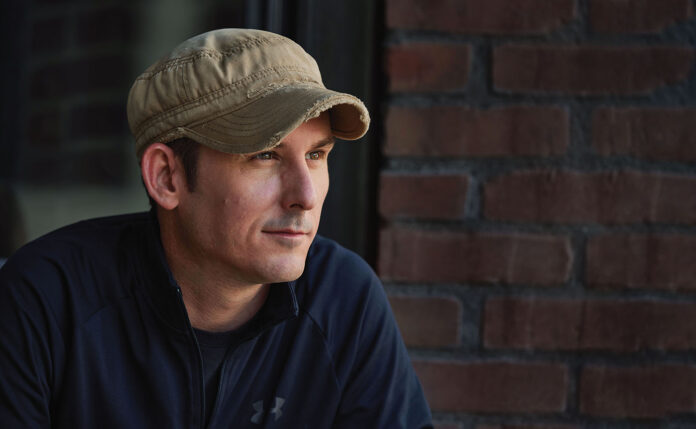






[…] Enlighten, deceptively homespun Kentuckian Jeremy Jacobs introduced dispensaries and product brands to a whole new marketing paradigm that quickly became a […]